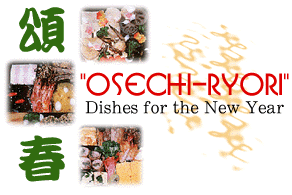|
Osechi means traditional dishes eaten to celebrate the New Year from January 1 to January 7. Gosekku are five special holidays which were brought to Japan from China. These days are called Jinjitsu (January 7), Johshi (March 3), Tango (May 5), Tanabata (July 7), and Choyo (September 9). There are special dishes for each day. The special foods eaten from January 1 through January 7 (Jinjitsu), called osechi-ryori, are typical of these traditional dishes. osechi-ryori, because it is special cuisine to celebrate New Year's Day, utilizes the special products of each district and foods which are considered to be good luck. The osechi-ryori is served in lacquer boxes, called jubako. The jubako come in stacks of two to five, but the most common is a stack of three boxes. We eat osechi-ryori with family, friends, and relatives over the New Year's holiday, while wishing for good harvests, prosperity for our descendants, and good health. In Japan, we invite many guests to our homes during the New Year's holiday. We make elegant osechi-ryori to offer to them. The preparation should be finished by the last day of the year, and it should be able to last for at least the first three days of the New Year. This is to free housewives from busy housework, and let them relax for the first three days of the New Year. But these days, homemade osechi-ryori is becoming rare, because we
can buy it already prepared at department stores, convenience stores, restaurants and home-delivery services. |
